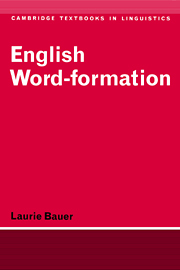Book contents
- Frontmatter
- Contents
- Dedication
- Preface
- 1 Introduction
- 2 Some basic concepts
- 3 Lexicalization
- 4 Productivity
- 5 Phonological issues in word-formation
- 6 Syntactic and semantic issues in word-formation
- 7 An outline of English word-formation
- 8 Theory and practice
- 9 Conclusion
- Bibliography and citation index
- Index
7 - An outline of English word-formation
Published online by Cambridge University Press: 05 June 2012
- Frontmatter
- Contents
- Dedication
- Preface
- 1 Introduction
- 2 Some basic concepts
- 3 Lexicalization
- 4 Productivity
- 5 Phonological issues in word-formation
- 6 Syntactic and semantic issues in word-formation
- 7 An outline of English word-formation
- 8 Theory and practice
- 9 Conclusion
- Bibliography and citation index
- Index
Summary
Behind a superficial appearance of simplicity there is concealed a perfect hornet's nest of bizarre and arbitrary usages.
(Sapir, 1949: 114)Introduction
The purpose of this chapter is not to provide an exhaustive survey of English word-formation, as this has already been done by, among others, Adams (1973), Koziol (1937) and, especially, Marchand (1969). Rather the intention is to provide an outline of types of word-formation in English, both productive and non-productive, to illustrate the range of patterns that exists in English. As a result, both lexicalized and non-lexicalized examples will be cited in this chapter, and in many cases there will be only brief comments on degrees of productivity. However, where the processes illustrated are still productive, recent examples showing the productive use will be included. Unless a specific source is listed for such recent examples, they are taken from Barnhart et al. (1973). This chapter is primarily taxonomic, and aims at presenting and illustrating a range of types of word-formation. However, a certain amount of theoretical discussion is also included, particularly where the discussion in the major sources about English word-formation is unsatisfactory (sometimes even totally lacking). Some theoretical comments will also be made, from time to time, on the implications of the taxonomy for a generative theory of word-formation, especially in cases where the boundaries of the categories are hard to define or where the transformational source of the complex words is not clear.
- Type
- Chapter
- Information
- English Word-Formation , pp. 201 - 241Publisher: Cambridge University PressPrint publication year: 1983

